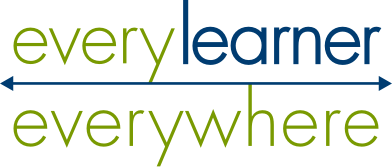When Every Learner Everywhere and its partners meet with educators, we sometimes encounter the perspective that digital learning is synonymous with online courses or with a range of modalities that include hybrid, hy-flex, and flipped. Conversations about digital learning that define it as online courses also tend to focus on which tools to use.
While teaching online and selecting tools are parts of digital learning, they aren’t the essential characteristics for Every Learner and its partners. We believe institutions of higher education and the professionals working in them need to think more expansively about what digital learning is. That begins by recognizing that the most important word in the phrase digital learning is learning and that learning is about the learner, not the teacher, and not the institution.
Every Learner and its partners advocate for conversations about digital learning that center the humanity of our students. We try to start conversations with big-picture questions about who students are, what our aspirations are for them, and what their own aspirations are for themselves. At Every Learner, our specific goal is equitable outcomes for Black, Latino, Indigenous, poverty-affected, and first-generation students.
In our work with institutions and individual faculty, we try to put questions about tools and modalities after questions about students and learning outcomes. Who are our students? What do they bring to the table? Is it that we want students to be able to think of their own original research questions? To be able to work in groups to develop a proposal together? To develop a creative expression of their ideas?
Implementing digital learning before centering our students’ humanity and considering questions like these won’t be effective. In fact, it’s likely to extend and amplify existing problems and inequities.
Digital learning addresses barriers
Even when big-picture goals and specific learning outcomes are well defined, it may still be premature to select the digital tools if other barriers to learning have to be confronted.
I often use the example of a hammer. Everyone should have this useful tool, right? But a hammer can be used to build or to vandalize. Even assuming good intentions, if the user isn’t skilled, a hammer will inadvertently bend a lot of nails. The tool isn’t the goal.
Some approaches to digital learning are like distributing hammers to faculty and students who will run into potholes on the way to the building site or who don’t all have access to the same blueprints when they get there. Similarly, digital learning is often hampered by outdated course design, teaching practices, assessments, support services, institutional policies, and professional development that don’t authentically center students. The practices and policies higher ed relies on are frequently driven by the institution’s needs instead of the students’ or were created with a limited set of students in mind.
In those conditions, an uncritical use of courseware, collaboration platforms, plug-ins to the video conferencing software, or any other tool won’t produce better learning outcomes. An expansive approach to digital learning involves first identifying and addressing systemic and institutional barriers that students and faculty face.
Digital learning asks students questions
We can use technology that honors students’ humanity if we focus on guiding them to use digital tools that help them put ideas into their own voices and support them to synthesize, shape, and share their own perspectives. Also, any meaningful discourse about digital learning needs to integrate student ideas about what makes a good teacher, a good classroom, or effective pedagogical strategies. I once attended a panel of students addressing those questions. The response that stuck with me was from a student speaking about a professor she felt stood above the rest. When we asked her why, she replied, “He saw me as a human being.”
That is borne out by several reports from Every Learner and its partners. For example, in What Our Best College Instructors Do: Reflections By Students About Meaningful Learning Experiences, the top findings are that:
- students want to be recognized as individuals and appreciated in the classroom;
- students value the connections instructors make between course content and “real life”; and
- students want to be treated with respect and trust.
Another of our original surveys show that students want their digital learning tools to promote community, collaboration, and belonging. Defining digital learning solely as online courses is unlikely to elicit that perspective.
Digital learning extends effective teaching practices
Digital technologies have the potential to enable flexible deadlines, choices in assignments, and having students’ own perspectives represented in the work that they’re doing. A broad examination of digital learning will seek out ways to extend those evidence-based practices.
I often see inspiring examples of this approach to digital learning from faculty who utilize the practices and philosophy of open pedagogy, which prioritizes having students create, contribute, and share knowledge, from their own perspectives, with an open license of their own choosing. In this way, students can feel that their learning is part of something broader as they contribute to their local and global communities.
With that approach in mind, faculty can have students use digital tools for creative activities such as collaborative annotation projects, podcasting, online poster sessions, website construction, video or written blogs, or online journaling. The term “online course” doesn’t begin to capture that potential, and uncritically using an online platform to reproduce an existing in-person course (that doesn’t already center and empower students) would never achieve it.
Educators have many more tools and environments available to us than just chalkboards and a circle of desks, and that means opportunities to be creative in our work. But we can’t lose sight of the fact that what we’re really trying to do is increase the success of all of our students — to empower them to know and understand something in a new way.
Digital learning accounts for context
The learning environment is also critical, and so digital learning is necessarily very context dependent. One context is the working conditions of the educator. It makes a big difference whether they are full time or part time, a clinical professor, supported by teaching assistants, supported by grants, or contingent faculty upon whom many significant decisions have been imposed.
Another context is the variety of institutions where digital learning happens, including R1s, community colleges, or institutions like HBCUs and TCUs (Tribal Colleges and Universities) that have unique richnesses as well as challenges that they face. A monolithic concept of the online course won’t be suitable in all those contexts.
Another part of the context of digital learning is the profit motive behind many of the digital tools available to us. The conversations that vendors encourage about software and purchasing can come at the expense of deliberate and critical conversations that center students in learning.
Students themselves introduce the most important variations in context. I sometimes hear faculty complain about students not being engaged when it would be more productive for faculty themselves to engage with questions of who their students are, what they bring to the table, how they work, and what motivates them. Our responsibility as educators is to understand their needs and to design learning opportunities — possibly to include digital technologies — that addresses that.
Digital learning starts with challenging questions
When something isn’t working in a program — for example, when minoritized and poverty-affected students have disproportionately low persistence and completion rates — the right question is unlikely to be about what tool to implement. Digital learning must step back and reorient using questions such as:
- What are we trying to do?
- Who are our students, what do they need, and how do we honor their humanity?
- What is particularly needed by the students who higher education has traditionally created barriers for, including Black, Latino, Indigenous, and poverty-affected students and other marginalized learners?
- Who developed the learning outcomes we’re using? Are we engaging our students in determining these outcomes?
- Who created this tool and who is deciding what’s going to happen with it? Does this tool possibly create more barriers rather than address them?
- What do we need to change about our work?
Understandably, busy faculty are also looking at the growing array of digital tools available to them and are seeking to settle the question of what tools they might use. For some, they will eventually have to make decisions like what works best with an LMS and how many modules to build. Also, there is value in getting into the nitty gritty of what the tech can do. Every Learner and its partners often feature innovative approaches to implementation in our consultation and training services, surveys and reports, blog posts, and workshops and webinars.
But exploring what technology can do proceeds much better if educators first step back and ask foundational questions and challenge unstated assumptions. Every Learner and its partners embrace an expansive discourse about and understanding of digital learning, and we engage a very broad range of perspectives — from students not least of all — in developing a vision for it. We hope you will join us in this conversation.
Download Listening to Learners 2023

